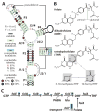A eubacterial riboswitch class that senses the coenzyme tetrahydrofolate
- PMID: 20659680
- PMCID: PMC3417113
- DOI: 10.1016/j.chembiol.2010.05.020
A eubacterial riboswitch class that senses the coenzyme tetrahydrofolate
Abstract
Comparative sequence analyses of bacterial genomes are revealing many structured RNA motifs that function as metabolite-binding riboswitches. We have identified an RNA motif frequently positioned in the 5' UTRs of folate transport and biosynthesis genes in Firmicute genomes. Biochemical experiments confirm that representatives of this new-found RNA class selectively bind derivatives of the vitamin folate, including di- and tetrahydrofolate coenzymes. In addition, representatives of this aptamer class occasionally reside upstream of RNA structures that are predicted to control translation initiation in response to ligand binding. These findings expand the number of coenzymes that are directly sensed by RNA and reveal possible riboswitch-controlled regulons that respond to changes in single-carbon metabolism.
2010 Elsevier Ltd. All rights reserved.
Figures


Similar articles
-
Biochemical validation of a second class of tetrahydrofolate riboswitches in bacteria.RNA. 2019 Sep;25(9):1091-1097. doi: 10.1261/rna.071829.119. Epub 2019 Jun 11. RNA. 2019. PMID: 31186369 Free PMC article.
-
Evidence for a second class of S-adenosylmethionine riboswitches and other regulatory RNA motifs in alpha-proteobacteria.Genome Biol. 2005;6(8):R70. doi: 10.1186/gb-2005-6-8-r70. Epub 2005 Aug 1. Genome Biol. 2005. PMID: 16086852 Free PMC article.
-
Confirmation of a second natural preQ1 aptamer class in Streptococcaceae bacteria.RNA. 2008 Apr;14(4):685-95. doi: 10.1261/rna.937308. Epub 2008 Feb 27. RNA. 2008. PMID: 18305186 Free PMC article.
-
Flipping the script: Understanding riboswitches from an alternative perspective.J Biol Chem. 2024 Mar;300(3):105730. doi: 10.1016/j.jbc.2024.105730. Epub 2024 Feb 8. J Biol Chem. 2024. PMID: 38336293 Free PMC article. Review.
-
Engineering and In Vivo Applications of Riboswitches.Annu Rev Biochem. 2017 Jun 20;86:515-539. doi: 10.1146/annurev-biochem-060815-014628. Epub 2017 Mar 30. Annu Rev Biochem. 2017. PMID: 28375743 Review.
Cited by
-
The Second Class of Tetrahydrofolate (THF-II) Riboswitches Recognizes the Tetrahydrofolic Acid Ligand via Local Conformation Changes.Int J Mol Sci. 2022 May 25;23(11):5903. doi: 10.3390/ijms23115903. Int J Mol Sci. 2022. PMID: 35682583 Free PMC article.
-
Identification of 15 candidate structured noncoding RNA motifs in fungi by comparative genomics.BMC Genomics. 2017 Oct 13;18(1):785. doi: 10.1186/s12864-017-4171-y. BMC Genomics. 2017. PMID: 29029611 Free PMC article.
-
Discovering riboswitches: the past and the future.Trends Biochem Sci. 2023 Feb;48(2):119-141. doi: 10.1016/j.tibs.2022.08.009. Epub 2022 Sep 20. Trends Biochem Sci. 2023. PMID: 36150954 Free PMC article. Review.
-
Structural basis for 2'-deoxyguanosine recognition by the 2'-dG-II class of riboswitches.Nucleic Acids Res. 2019 Nov 18;47(20):10931-10941. doi: 10.1093/nar/gkz839. Nucleic Acids Res. 2019. PMID: 31598729 Free PMC article.
-
Employing a ZTP Riboswitch to Detect Bacterial Folate Biosynthesis Inhibitors in a Small Molecule High-Throughput Screen.ACS Chem Biol. 2019 Dec 20;14(12):2841-2850. doi: 10.1021/acschembio.9b00713. Epub 2019 Nov 14. ACS Chem Biol. 2019. PMID: 31609568 Free PMC article.
References
-
- Breaker RR. Complex riboswitches. Science. 2008;319:1795–1797. - PubMed
Publication types
MeSH terms
Substances
Grants and funding
LinkOut - more resources
Full Text Sources
Other Literature Sources

